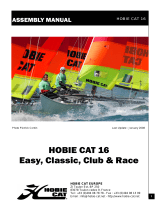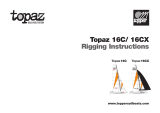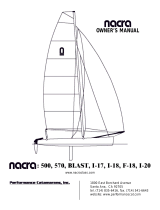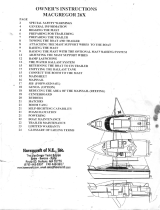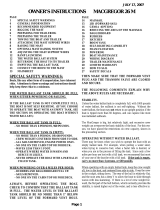Page is loading ...

$66(0%/<0$18$/
7$%/(2)&217(17
List of parts.......................2
Hull assembly ...................4
Trampoline........................5
Rudder assembly..............7
Tiller crossbar & stick........8
Mast set up.......................9
Spreader bars.................10
Preparation for mast
assembly ........................11
Stepping the mast...........12
Trapeze.......................... 13
Boom.............................. 14
Mainsail.......................... 15
Cunningham................... 16
Jib .................................. 17
Jib sheet system ............ 18
Main sheet system......... 19
Pre sailing...................... 20
Spinnaker Kit.................. 21

Tools necessary :
⇒ 2 spanners - No. 17
⇒ 1 pair of universal pliers
It is advisable to have at least 2 people to assemble
the Hobie Fox .
LIST OF PARTS
Hulls (2)
Front crossbar
Rear crossbar
Mast
Boom
Trampoline & rod
Rigging bag
Wire bag
/,672)3$576
&$87,21'$1*(5
$/80,1,800$6767$<$:$<2)
(/(&75,&$/:,5(6
Daggerboards (2)
Ropes bag
Rudder assemblies (2)
Tiller crossbar
Tiller extension
Mainsail + battens (7)
Jib
Spinnaker kit + spinnaker (optional)

/,672)3$576
WIRES :
1. Shrouds
2. Bridles
3. Spreader diamond wires
4.5. Jib halyard + forestay
6.7. Trapeze wires
8. Spreader assembly
9. Stay adjuster cover
10. Jib furler
ROPES :
All ropes are labelled with ref. number
and name. Please check carefully be-
fore using.
1. Righting line (white)
2. Trapeze shock cord
3. Jib sheet (yellow)
4. cunningham line (red)
5. Mainshjeet (black and yellow)
6. Jib halyard rope
7. Jib luff tensioner line
8. Rotation line
9. Jib sheet tangle preventor
1
2
3
4
5
6
7
8
9
1
2
3
4
5
6
7
8
9
10

+8//$66(0%<
Position the hulls in parallel with the inner
sides facing the ground.
Lift the right hull. One person straddles the hull to
hold it in place. The other person applies the silicone
sealant (for waterproofing) around the screw holes.
.
Take the front crossbar (with dolphin striker).
Place it in its support so that the trampoline
track faces the rear of the boat. Insert the two
bolts. Pass your hand through the inspection port to
position the nuts and washers onto the screws
photo). Fasten loosely.
Lift the left hull, and follow the same steps as for the
right hull. Do not fully tighten the screws.
***Respect same order for the washers as assem-
bled at the delivery***
Apply silicone sealant around the screw holes
at the back of the hulls. Place the rear cross-
bar on the right side. Insert the bolts, washers
and nuts as shown for the front crossbar. Do the
same thing for the left side.
Once the frame has been mounted, tighten all the
bolts fully and then install the lock nuts.
NB : it is advisable to check the fastening of the bolts after the first
trip out onto the water, and recheck these at regular intervals.

Commence lacing and tensioning the
trampoline. The lacing line ties off and
starts on the rod at the rear left. Pass it
around the far left lacing post and back
around the rod in the first cut out. Now bring
the line once more around the 1
st
lacing post
and lead to the 2
nd
lacing post. The line then
passed around the lacing rod and is led back
to the 2
nd
lacing post. Pass it behind the line
and head towards the 3
rd
lacing post. Conti-
nue all the way across in the same manner.
75$032/,1($66(0%/<
When the trampoline is pulled all the
way to the back of the boat insert the
fibreglass-lacing rod into the rear flap.
Unfold the trampoline and insert the
front sealed edge part of the trampo-
line into the trampoline track of the
front crossbar.
NB : To ease feeding the trampoline into the
track and hull cut-outs liquid soap may be
used. Be sure to wash off before sailing.
Insert the right and left-hand rear cor-
ners of the trampoline into the corres-
ponding cut-outs in the hull. Pull back
evenly.

75$032/,1($66(0%/<
When the trampoline is tensioned
evenly tie off the lacing at the right
hand rear corner.
NB : The trampoline must be tight.

Identify the right rudder from the left rudder
(green sticker = right ; red sticker = left)
Take the left rudder, place the washers as shown in
the photo, then align the rudder casting onto the
gudgeon.
58''(5$66(0%/<
insert the rudder pin, and do not forget to put in
the two split rings: one on top and one at the
bottom of the rudder pin.
Repeat the procedure for the right rudder as-
sembly.

7,//(5&5266%$567,&.
Take the tiller crossbar and insert the right
side into the right rudder arm and the left side
into the left rudder arm.
Take the yoke connection of the tiller extension
and fix it into the middle of the tiller crossbar
Then fix the tiller head into the yoke connection
as shown on the photo.

0$676(783
Place the mast onto two supports or padding.
Unroll the trapeze wires and fix them using the 6 mm
bow shackle to the upper hole on the mast tang (two
on each side).
Unroll the shrouds and the forestay wire (with
the jib halyard block) and fix them to the lower
hole of the mast tang using the 8 mm bow sha-
ckle. The shrouds go onto each side of the forestay.
7UDSH]HZLUHV
7UDSH]HZLUHV
6KURXGV
)RUHVWD\
IMPORTANT : Do not forget to attach the jib ha-
lyard rope to the small single block at the end of
the jib halyard wire. Tie off the jib halyard wire
and rope near the base of the mast.
NB
: If you have chosen the optional spinnaker kit, fit
the spinnaker halyard now, passing it behind the ha-
lyard yoke and around the pulley. Both ends then go
over the shrouds and trapeze wires. One end of the
halyard passes between the spreader arm and brace
on the starboard side of the mast. Secure both ends
near the base of the mast.

Unroll the diamond wires. Unwind the top of the
large turnbuckle all the way – leave 6 or so
threads so it does not come apart.
Attach the thimble at the bottom of the diamond wire to
the top of the turnbuckle.
NB
: It is a good idea to equalise the length of the two
sides of the diamond wire by adjusting the small turn-
buckle.
635($'(5%$56
Assemble the spreaders onto the spreader roots
on the mast using the clevis pins and split rings.
The spreader brace (the longest part) is fixed to
the front of the mast and the spreader arm (shortest)
to the back.
Slide the diamond Wires into the slots at the end
of the spreaders. Ensure the plastic disk (jib pro-
tection) is mounted above
the spreader. Secure
the diamond wire with the cotter pins provided.
Advice
: Cover all split rings and pins on the spreader
bars with ducting or amalgamating tape. Wrap some
tape on the wire above the disk to prevent it riding up
the wire.
Attach the terminal fork ends to the diamond
tangs mounted just below the shroud tang. Tape
these pins up as well.
Wind in the desired tension. Make sure that all locking
nuts are tightened after tension/rake is set.

35(3$5$7,21)250$67$66(0%/<
Lay the mast on top of the boat with
the sail track to the bottom and the
mast base toward the bows.
NB : place padding under the mast to pre-
vent scratching.
Lay the shroud wires and trapeze wires
down each side of the mast. Secure the
trapeze wires temporarily near the base
of the mast.
Ensure that the shroud anchor pins are
sealed, tight and pointing at 90° to the
centreline of the hull. Attach the twist
toggles to the anchor pins using the clevis
pins and rings. If you have the optional spin-
naker kit use the 6-mm bow shackles provi-
ded instead of the clevis pins .
Attach the stay adjusters to the twist toggles
with the clevis pins and rings.
Attach both shrouds into the top hole of the
respective stay adjusters. This is only a tem-
porary position for raising the mast.
Attach the bridle wires to the bow
tangs.
Now, attach the jib furler to the bridle wires.
NB : Ensure that the hole in the furler hou-
sing is facing towards the front crossbar.
Now also is a good time to roll some line
onto the furler drum. Leave enough line un-
furled to reach the front crossbar mounted
furler cleat.

67(33,1*7+(0$67
Place the mast foot on the
mast base and place the pin in
it. This prevents the mast from
leaving its base when lifted.
Check that the wires are not tangled.
Then, with one person on the trampoline, the
second person lifts the mast by the top and
moves down the mast until the person on the
trampoline can take the mast on their shoulder.
Then this person pushes his feet against the rear
crossbar and pushes the mast forward with the
weight of his body.
The first person is to push the mast up as far as pos-
sible, walking ahead on the trampoline as the mast is
raised.
The second person can
now take the forestay,
make sure it is not tan-
gled and pin it into one of the
top holes of the furler mounted
stay adjuster.
Once the mast is secure remove the bolt from
the base of the mast and stow it in a secure
place. You will need the bolt later for safe lowe-
ring of the mast.
Now you can affix the cunnin-
gham blocks to the brackets
on each side of the mast.
NB : FOR THE FIRST FEW TIMES YOU
RAISE THE MAST IT IS RECOMMENDED
YOU USE 3 PEOPLE FOR EXTRA SAFETY.

75$3(=(
Release the trapeze wires from the base of the mast. The crew’s trapeze has the clamcleat swaged to
the wire. The skipper’s trapeze has the small block swaged on. Ensure that the crews trapeze wire is po-
sitioned in front of the shroud.
Attach the trapeze handles and kits to the trapeze wires.
Pass the trapeze shock cords (the crews is slightly longer than the skippers) underneath the trampoline
and up through the grommets at the side of the trampoline. Attach to the trapeze system as shown in the
photographs.
CREW TRAPEZE SKIPPER TRAPEZE

%220
Connect the boom to the mast using the hinge
vertex, clevis pin and split ring.
Tie one end of the rotation line to the front of the
clamcleat on top of the boom. Pass the other
end of the line through the end of the rotation
arm on the mast. Take the line back through the clam-
cleat and fit a plastic ball stopper at the end.

0$,16$,/
* Always point your Hobie into the wind before raising the sails. *
Unfold the mainsail on a clean surface and insert each batten into its respective pocket. The battens are
numbered from 1 to 7. Number 1 goes at the top and number 7 at the bottom of the sail. Secure the battens in
the pockets with the batten ties – as shown in the photographs.
Undo the halyard rope, which is attached to the
mast. Pass the end through the hole in the
headboard and tie off with a figure «8» knot.
Feed the luff of the mainsail into the opening of
the mast track ensuring that the hook is on one
side of the mast and the halyard on the other
side. Ensure that the halyard inside the track stays in-
side the track.
Raise the sail by pulling the halyard and feeding the
sail into the opening. When the sail is all the way up
turn the mast slightly so that the hook will engage in
the halyard lock when you pull down on the sail. Insert
the bottom part of the luff into the lower section of the
mast track. Roll up the halyard and place it in the tram-
poline pocket.
Attach the clew of the mainsail to the shackle on
the boom outhaul car assembly.

&811,1*+$0
Shackle the cunningham blocks into the grommet of the mainsail tack. Take the cunningham line and
feed as follows : (NB : the line must go through the inside of the rotation arm)
- Start from the cunningham block ont the left side of the mast. Feed the rope into the cleat around the
sheave
- push the cord up through the first sheave of the left block from back to front
- take the rope back down, thread it through the left sheave at the base of the mast from front to back
- take it up through the second sheave of the left block from back to front
- take it back down and through the single block,
- take it back up into the first sheave of the right hand block from front to back
- take it back down through the sheave at the right of the mast base from back to front
- take it up through the second sheave in the right block from front to back
- finally thread the line through the cunningham block and in the cleat.
Attach each end of the cunningham line to the shrouds.
Take the righting line from the rope bag. Attach it to the dolphin striker post under the front crossbar
(photo). Pass it under the trampoline through the grommet at the base of the mast. Fold up the end of
the line and stow it in the trampoline pocket at the base of the mast.

Once the jib is fully raised, take the jib luff ten-
sioner line and secure it to the bottom holes in
the stay adjuster.
-,%
Unroll the jib and open the
zipper on the luff. Using the
4mm bow shackle connect
the tack to the stay adjuster.
Shackle the two clew blocks to
the clew plate using the 4mm
bow shackle provided.
Shackle the jib head to the jib
halyard. Then position the jib
and the halyard line against
the forestay.
Close the zipper ensuring that the ha-
lyard line remains inside the zipper.
As you pull down on the halyard line
close the zipper as the sail is raised.
Now pass the line through the small pulley at the end of
the jib halyard, then back down through the cleat on the
tack of the jib.
Now remove the jib halyard line and stow it in the trampoline po-
cket.

Pass the sheet line behind the
mast (but above the cunnin-
gham lines) and duplicate pro-
cess for the other jib car and clew
block.
-,%6+((7
Take the jib sheet (yellow) push one end down through the hole
at the front of the jib car plate and tie off with a figure «8» knot.
Take the other end of the sheet and pass it
through the corresponding jib clew block and then
back down through the fairlead on the jib car.

Thread the tail of the main sheet through the
swivel cleat assy on the rear beam, through
the sheaves on the traveller car, down through
the eyestrap on the rear of the beam and tie a
figure «8» knot in the end.
0$,16+((76<67(0
Your mainsheet system has been pre-
assembled for you. If you have problems ask
your dealer.
Shackle the
boom block to
the boom block
hanger.
Shackle the main-
sheet ratchet block
to the top of the
main traveller car.

35(6$,/,1*
Install the drain plugs – do not overtighten, hand
tight is sufficient. Overtightening may cause the
drain plug flange to distort and cause leakage.
Tension the rig. This can be accomplished by ha-
ving your assistant hang from the trapeze or you
can use mainsheet tension on one side at a time
so that you can adjust the shroud position in the side
stay adjusters.
Fit the daggerboards into the daggerboards wells.
The daggerboard roller shock cord should be tight
enough to prevent the daggerboard from slipping
down.
It is recommended that beach rollers be used to
move your Hobie Fox. This will save your back
and the bottom of the boat.
Always wash traveller with fresh water after use in
salty water.
Always wear your Hobie buoyancy vest, look out for
overhead power lines and HAVE LOTS OF FUN!
/

